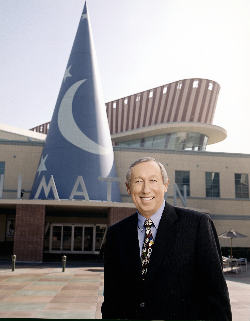Rhett Wickham: Oh Captain, My Captain...
Page 1 of 2
Only one day after the 43rd anniversary of the passing of Walt Disney, former animation executive and Board member ROY EDWARD DISNEY has died. He was 79 years old. The son of the Disney empire’s less celebrated founder, Roy O. Disney - the financial and business brains behind the creative genius of his younger brother Walt - Roy E. went from self-effacing live action documentary producer to leader of not one but two movements that shook the House of Mouse to its very foundation. Both times, Disney’s efforts, to set things back the way his father and his uncle would have wanted, resulted in critical change that helped the company survive corporate pirates and Wall Street pundits who were more interested in bad press. It also resulted in countless personal attacks, and strained relations with his cousin, Walt’s surviving daughter, Diane Disney Miller. But to the very end, it was the company and the name on the gate that Roy protected and preserved with all his heart. Veteran Disney producer, director and writer Ron Clements graciously spoke exclusively to Laughing Place from his offices in Burbank, shortly after learning the news of Disney’s death. “I loved Roy,” said Clements. “When animation was in bad straights in the 80’s he really rescued us and helped us come back.” Clements and co-director John Musker pitched Roy their story for Disney’s return to hand-drawn animation, “The Princess and the Frog”, over four years ago. He was enthusiastic about the project, and it was the directors’ hope that Roy would survive to see the finished film, although his struggles with stomach cancer likely prevented this. Nonetheless, he would be proud, as the feature stands as a sort of final testament to Roy’s unwavering support for the film-making style that made Disney…well, Disney. Roy E. Disney was elected to the Disney Board in 1967, less than a year after Walt’s death. Following a “lackluster” period of decline, Roy resigned his executive position with the Studio, in 1977, but remained on the Board until stepping down seven years later to help orchestrate a company coup that removed his cousin-in-law and former NFL player, Ron Miller, as CEO. Like his father before him, Roy E. Disney was a shrewd negotiator and a savvy man of business. But he always had any eye to what was at the heart of the company, and in spite of what ill-will the removal of Miller may have fostered between Roy and his cousin Diane, it was Walt and Roy O.’s vision that he truly believed he was protecting. With the arrival of Michael Eisner, Roy E. Disney picked up where he left off, or rather, where he had begun nearly forty years earlier – clocking-in, as it were, and putting in a full day’s work on the lot. Like his uncle before him, Roy became a familiar face in the halls of animation during the company’s resurgence in the 1980’s. With a push from Roy, animation managed a tour-de-force turn-around act that started with “Great Mouse Detective” and “The Little Mermaid”, the former co-written by and the latter co-written and co-directed by Ron Clements. “He was a very low key, self deprecating guy,” remembers Clements. “Roy was very humble. He was very intelligent, and he gave us great notes. He didn’t come from animation, but he really loved the medium, and he understood it. He loved animation and was a cheerleader. It could have gone away if wasn’t for him. When Michael (Eisner) and Jeffrey (Katzenberg) came in, they didn’t know much about animation, and it was Roy who guided them through an understanding of it and how important it was to the company. He understood the philosophy and he was determined to make sure that that was preserved.” While so much credit for the so-called Renaissance was given to the more public and much more showman-like Katzenberg, the artists of this period in Disney’s history will all tell you the same thing – Katzenberg was the magic feather, and the real lucky star making things fly was Roy Disney. It was Disney who suggested the hiring of Peter Schneider, the most successful of the long-line of (then) Feature Animation department heads. It was Disney, too, who championed the renewal of one of Walt’s greatest unrealized dreams – the continuation and expansion of the “Fantasia” program, which resulted in the beautifully crafted “Fantasia 2000”. Whenever the studio needed a stamp of approval and the sheen of authenticity on a project or product, it was Roy O. Disney whose signature turned up on the report or marketing materials or product packaging. It was as good as saying “Walt would have done it like this.” But there was one thing that, clearly, Roy felt Walt would not have done, and that was cheapen the value of the Disney brand by over-exposing and over-franchising it into the ground. That’s what Roy and so many others felt had become the m.o. of Michael Eisner by 2003. What followed was arguably the most public feud any major contemporary American corporation hung out on the laundry line for everyone to see and hear.
